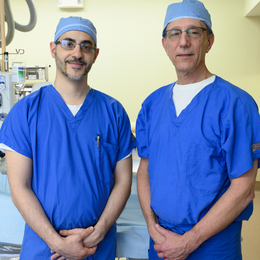
Whole Hearted
The Structural Heart Program at St. Mary Medical Center offers minimally invasive options capable of delivering life-changing results for patients affected by heart disease.
For being one of the most powerful muscles in the body, the heart is surprisingly vulnerable. Heart disease is the leading cause of death among men and women in the United States, claiming the lives of more than 647,000 Americans per year, according to the U.S. Centers for Disease Control and Prevention.
Such sobering statistics aside, the treatment of heart disease has made astonishing advances in recent years. The advent of minimally invasive technology being pioneered by hospitals such as St. Mary Medical Center in Langhorne has enabled the effective treatment of heart disease without complex open-heart surgery.
Led by interventional cardiologists such as Ronald H. Fields, M.D., FACC, who is also the medical director of the St. Mary Heart & Vascular Center, and Roi Altit, M.D., FACC, the Structural Heart Program at St. Mary Medical Center has adopted a number of these technologies with remarkable results. The doctors cite four minimally invasive procedures that have helped to improve patients’ quality of life and, in some cases, saved patients’ lives.
* TAVR. Short for transcatheter aortic valve replacement, TAVR is a minimally invasive option for patients with advanced aortic stenosis, or the narrowing of the aortic valve, which makes the heart have to work harder. TAVR is performed through a small puncture in the upper thigh or in the side of the chest wall, through which a catheter is inserted into the artery. The new heart valve is then delivered through the catheter and precisely positioned within the heart.
“It’s essentially a way to replace the aortic valve without open-heart surgery,” says Dr. Altit. “When TAVR was first approved by the FDA in 2012, it was initially made available to inoperable patients, but it has since shown excellent results in patients in lower-risk groups.”
At St. Mary, the TAVR procedure incorporates a cerebral-protection device known as SENTINEL. The ancillary device captures and removes any blood-clot debris, which protects the patient’s brain from stroke during the procedure.
* LOTUS Edge. This next-generation TAVR valve prevents paravalvular leak, referring to any blood leaking between a patient’s natural heart tissue and the valve replacement. The device’s braided nickel-titanium alloy frame and adaptive seal technology enable it to conform to the patient’s anatomy, thereby eliminating paravalvular leak. The device is also fully repositionable, meaning a surgeon can recapture the device after deployment and then reposition it for the most optimal outcome.
“One of the Achilles’ heels of TAVR is that you don’t always get a beautiful seal, and this combats that issue in two ways—by filling any open spaces, and by molding to the patient’s anatomy,” says Dr. Altit. “Now there’s no reason to leave a leak behind. It’s a big step forward.”
* MitraClip. When the heart’s mitral valve does not close tightly, it prevents the efficient flow of blood through the heart and to the rest of the body—a condition called mitral regurgitation. Patients with this condition often feel tired and out of breath, though severe cases can contribute to heart failure. In this transcatheter procedure, the small MitraClip device is attached to the heart’s mitral valve to restore the proper flow of blood from the left atrium to the left ventricle.
“This is one of the most gratifying procedures I do because patients tell you the next morning that it feels so good to walk around without shortness of breath,” says Dr. Altit. “It also significantly reduces mortality. Many of the patients we’re doing this procedure for are too sick for surgery, so we’re literally saving their life, not just improving their symptoms.”
* WATCHMAN. The WATCHMAN offers a minimally invasive solution to atrial fibrillation, a form of cardiac arrhythmia that can lead to blood clots and stroke originating in the left atrial appendage. By occluding this vulnerable part of the heart, the device reduces the risk of stroke in a manner that’s on par with a blood thinner such as warfarin. It is a one-day procedure that can reduce one’s risk of stroke for a lifetime.
“St. Mary has been incredibly dedicated to staying on the forefront of technology,” says Dr. Fields. “We were the first in the county to have a catheterization lab, the first to do a coronary angiogram, the first to use bio-absorbable stents, the first to do TAVR. When new devices come out, [device manufacturers] come to us first, because they know the quality of the staff and the hospital.
“Every member of the team works well together here,” he continues. “The cardiothoracic surgeons, interventional cardiologists, and other specialists on the Heart Team at St. Mary come together and share their expertise, and that makes a huge difference in the delivery of patient care. Otherwise, we wouldn’t have been able to accomplish what we’ve been able to accomplish here. It’s an exciting place to be.”
For more information about St. Mary Medical Center’s Structural Heart Program, visit stmaryhealthcare.org/heart or call (844) 7 ST MARY.
Photography courtesy of St. Mary Medical Center
Published (and copyrighted) in Suburban Life magazine, February 2020.


